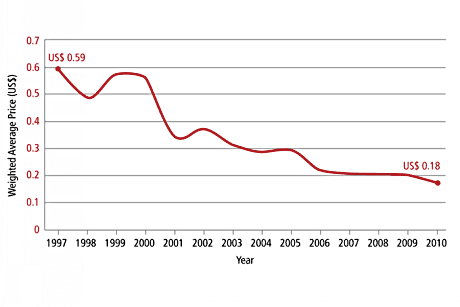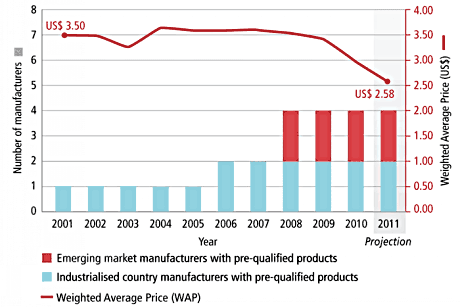
Price decline of hepatitis B vaccines. Source: UNICEF Supply Division, 2010.
Underlying the GAVI Alliance business model is an intention to ensure a lasting impact on the vaccine market to the benefit of the developing world.
There is growing evidence that increased demand for GAVI-funded vaccines is encouraging more suppliers into the market and the competition, together with new technologies, is helping to lower the price of some specific vaccines:
Hepatitis B monovalent
The price of hepatitis B (hepB) monovalent vaccines started to to decline in the early 1990s. The technology for producing the vaccine had become relatively simple and efficient, and manufacturers from emerging economies started producing the vaccine at low cost.
With increased competition, and support from GAVI since its launch 2000, prices have continued to decline. Since 2000, the price of the vaccine has fallen by 68%, dropping from US$ 0.56 to US$ 0.18 per dose.1
Tetravalent vaccines (diphtheria-tetanus-pertussis-hepB)
GAVI-funded demand for tetravalent vaccines (DTP-hepB) has increased the number of suppliers in the market from one to seven, including some from emerging economies. This has seen tetravalent vaccine prices decline from a peak of US$ 1.26 in 2006 to US$ 0.71 in 2009. 2
Pentavalent
Number of manufacturers and price decline of pentavalent vaccine.
Source: UNICEF Supply Division, 2010.

In 2011, GAVI is projected to pay US$ 2.583 per dose of the combination pentavalent vaccine (DTP-hepB-Haemophilus influenzae type b). This represents a decrease of 29% since 2007, when most GAVI-eligible countries switched to pentavalent and the price per dose was US$ 3.61 -- a drop attributable to the number of manufacturers competing in the market having grown from one to four.
The growth in predictable demand for DTP-hepB-Hib, supported by GAVI funding, has now created the sustainable market required to attract manufacturers, create competition and lower prices.
UNICEF's Supply Division expects further price decreases in the coming years. 4
Pneumococccal vaccines
The Advance Market Commitment for pneumococcal vaccines accelerated the production of more appropriate and affordable vaccines for low-income countries.
GAVI will pay a price of US$ 7 per dose for the initial vaccines procured from each supplier and a price of US$ 3.50 or lower for the majority of doses procured thereafter. This represents a price reduction of more than 90% compared with the same vaccines sold in high-income countries.
The price is expected to decline further with increased competition.
Meningitis A
Meningitis A vaccine is being procured for close to US$ 0.50
1 Chee G, Molldrem V, His N, Chankova S. Evaluation of GAVI Phase 1 Performance. Bethesda, MD: Abt Associates Inc. 2008 Oct.
2 UNICEF, Supply Division product menu files
3 UNICEF Supply Division communications with GAVI Secretariat.
4 GAVI Alliance. GAVI's impact on vaccine work market is bringing down prices [quoting Dr.Ibrahim El-Ziq, Chief of the Immunization Center at UNICEF's Supply Division]. 2009 Nov 18 [cited 2010 Feb].
